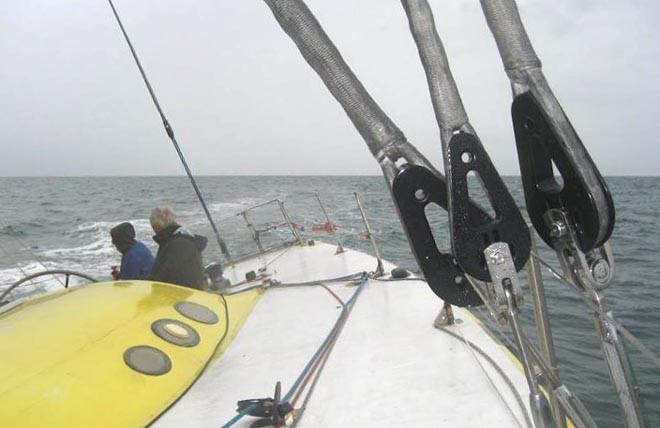The ten year sailing boat refit, and what to look for...
by BoatUS/Sail-World Cruising on 9 Feb 2013

Ten year refit - time to change your standing rigging SW
Birthdays for people seem more relevant when you pass a new decade and have a 'big birthday'. Sailing boats are a little the same. Every ten years or so marks a time of change and renewal. Here BoatUS offers some hints about what you should look for in a major check every ten years:
Standing and running rigging:
The ten year refit will, most importantly, include the standing rigging. When was the last time you had a close look at all of the fittings and mast attachments (even the ones up high)? Ten years (eight years for rod rigging) is a long time for rigging on boats that are engaged in long range cruising, but even those used for day sails can suffer from the cyclical loads that cause stress cracks, and saltwater can cause corrosion in swaged fittings not easily seen by the naked eye. As the loss of a mast at sea is not anyone's idea of a pleasant sail, the conservative view is that, at ten years, the standing rigging should be renewed. It is a good idea to check with your insurance company about their view on payouts for rigging failures as they age.
Seacocks/Through Hulls:
The next most important issue is the skin fittings, as a faulty skin fitting can cause your boat to start sinking at the most unexpected time. If it's been years since one has been fully opened and closed, it could be frozen, and that's useless. Make it a point to work seacocks a few times each season and while you're there, check the hose clamps. Also make sure that the emergency plugs are all in place and haven't fallen away from beside the skin fitting, where they should be fastened.
Bilge pumps:
A ten-year old bilge pump has likely lead a tough life. Switches are often the first to go, so make sure yours works fine by pouring water in the bilge to activate the pump, making sure nothing interferes with the switch. Take a close look at wire connections as they often are near or in standing water at the bottom of the boat.
Fuel hose:
When it was new, the fuel hose did a great job of delivering fuel to the engine. Over time, however, fuel can permeate the hose wall causing damage. Take a rag around the hose, wipe it down and then smell the rag. If you smell fuel, replace hose immediately. If you do have to replace, always install new hose clamps, too.
Winches:
No doubt you have been regularly servicing your winches, but the ten year refit is a good time to check the bearings carefully.
Steering and control cable:
Like an arthritic knee, bend the cable in your hands and listen for 'crunching,' a telltale sign that all is not well. Swelling and rust are also bad signs and indicate it's time to replace.
Electrics:
The marine environment is not kind to any kind of electronics. Check all electrics for corrosion, with particular attention to the Nav lights as a safety feature.
Caulked fittings:
The boatyard rule of thumb is that after 10 years, the bedding compound owes you nothing. Begin a schedule to periodically remove and rebed fittings, doing a few each year so the job isn't overwhelming. This will keep the leaks out that could lead to more expensive repairs.
Prop:
Eventually all props get dinged, and you may not see the damage clearly with your eye. If it's never been to a shop, now is a good time to take it to a prop shop for reconditioning, and you'll also likely save some money on fuel with a tuned prop. It is particularly important to check feathering or folding props regularly. Check the alignment of the prop shaft.
Other drive gear:
The cutlass bearing might be due for replacement, especially if there's more than just a smidgen of play in the drive shaft. It's also time to take a hard look at the stuffing box. If you've had to re-tighten the stuffing box nut often, it's time to replace the packing.
Engine:
Check that the engine mounts are not perished and are still functioning well. The heat exchanger should be taken apart to make sure there is no corrosion.
Keel bolts:
If you have keel bolts, this is a certain time to check them for corrosion.
Exhaust manifolds:
Unless you sail in fresh water, if you still have the original manifolds, thank your lucky stars they haven't failed yet. Now is the time to do some proactive maintenance to replace them. 'Leaking manifolds can destroy an engine,' said BoatUS Seaworthy Magazine Associate Editor Chuck Fort.
About Boat US: Boat Owners Association of The United States is an American association of boat owners offering various services and recreational boat and trailer towing activities. Among their services are boat insurance and boat loans, discounts on boating-related products and services, mediation services with manufacturers and dealers, a product recall alert registry, and lobbying organization on behalf of boat owners.
Did you like this article? Did you know that you can have all your non-competitive sailing news in one easy-read news magazine delivered direct to your inbox each week, simply by subscribing FREE to Sail-World Cruising? Stay up-to-date with what's happening on the water: everything from sailing adventures to new products, from rally news to new ideas and old tricks. Simply http://www.sail-world.com/CruisingAus/newsletter_subscribe.cfm!click_here now!
If you want to link to this article then please use this URL: www.sail-world.com/106391